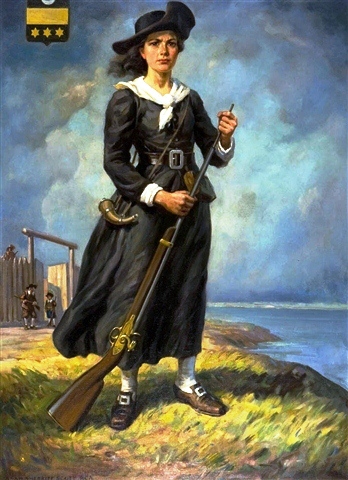Tags
Carignan-Salières, Filles du Roy, Grace Lee Nute, Iroquois, New France, Noble savage, Pierre Jarret de Verchères, Pierre-Esprit Radisson
My next post is a continuation of the Noble Savage, but I will pause briefly and deal with not-so-noble Amerindians by telling the story of Madeleine de Verchères[i] (3 March 1678 – 8 August 1747). Given the discrepancies between versions of this story, accuracy may remain a goal.
Madeleine de Verchères
In 1691, the Iroquois, the most ferocious among Amerindians and allies to the English, grew particularly aggressive. On 22 October 1692, at eight in the morning, the Iroquois captured about twenty settlers working in the fields, as was Madeleine. One caught up with Madeleine and grabbed her by her scarf. Madeleine untied her kerchief and got away.
Madeleine was the fourteen-year-old daughter of a seigneur. According to one account, she lived in a castle, but it appears she lived in a fort with other settlers, soldiers and cattle. Her father, François Jarret de Verchères[ii] had been a soldier with the Régiment de Carignan-Salières and would have built a fort, not a castle. On the day of the attack, 22 October 1692, only one soldier was at the fort.
Madeleine’s mother is described as a 33-year-old widow in one account, but according to another report, she and her husband were not at the fort on an infamous day. They had gone to purchase supplies.
Having entered the fort, Madeleine went to the bastions where there was a cannon. Madeleine fired the cannon to warn others and to call for reinforcement. (Madeleine de Verchères, Wikipedia)
She then asked the settlers and the soldier to make a massive noise so the Iroquois would be fooled into thinking the fort was well protected, and she started firing. She drove the Iroquois away, but they took the men they had captured.
According to Wikipedia, at one point, Madeleine noticed that settlers, the Fontaine family, were in a canoe returning to the fort. The soldier was too afraid to run to the landing dock and lead the Fontaine inside the fort, so Madeleine ran out and took them in.
In the Wikipedia entry, it is also reported that, when evening came, the cattle returned. Fearing that Iroquois were behind the cattle, Madeleine and her two brothers went out of the fort, under cover of darkness, to make sure there were no Iroquois dressed as cattle. The cattle had returned on their own and walked into the fort.
As for the captured settlers, they were tortured, which means that they were burned. It appears that these unfortunate captives were saved by a party of friendly Amerindians who found them in the region of Lake Champlain. It was possible to survive torture, depending on the severity of the wounds, the length of time the victim was tortured and resistance on the victim’s part. Pierre-Esprit Radisson was captured and tortured by Amerindians and survived.[iii]
However, an alternate and merciful account has a different ending. The day after the attack, reinforcement arrived, and the settlers were released. Madeleine reported that there were two deaths.
* * *
Despite differences, the accounts of Madeleine de Verchères tell of a young woman who saved a fort. Madeleine Jarret de Verchères is a Canadian heroine. Madeleine’s story was recorded by historian Claude Charles Le Roy de La Potherie.[iv]
_________________________ [i] André Vachon, “Jarret de Verchères, Madeleine,” Dictionary of Canadian Biography Online. http://www.biographi.ca/009004-119.01-e.php?&id_nbr=1418 [ii] Céline Dupré, “Jarret de Verchères, Pierre,” Dictionary of Canadian Biography Online. http://www.biographi.ca/009004-119.01-e.php?&id_nbr=858 [iii] Grace Lee Nute, “Pierre-Esprit Radisson,” Dictionary of Canadian Biography Online. http://www.biographi.ca/009004-119.01-e.php?&id_nbr=1052 [iv] Léon Pouliot, “Le Roy de la Potherie, Claude Charles,” Dictionary of Canadian Biography Online. http://www.biographi.ca/009004-119.01-e.php?&id_nbr=947 © Micheline Walker 15 November 2012 WordPress


Micheline, my dear, thank you so much for this story. I love it! Movie also, I love it!
Your post has enchanted my soul and thank you!
Hope you have a wonderful day! Big hugs always with love, Stefania! 🙂
LikeLike
Dear Stefania, I thank you for your kind comments. Madeleine de Verchères is well known, particularly in Quebec. She was a brave girl and the daughter of an officer of the Carignan-Salières Regiment who were sent to Quebec in 1665 to protect the colony and 400 of the soldiers remained in Canada. I just published a post about the Carignan-Salières regiment. The settled New France. Big hugs and Love, Micheline
LikeLike
Is Madeleine well known over Canada (or Quebec)? How did you hear about her? This was an touching strory;
Have a peaceful WE, dear Micheline, and my best wishes for the medical operations ahead xx Lou
LikeLike
Dear Lou,
Madeleine de Verchères is a celebrity in Quebec. I learned about her in school. But I do not know whether she is known outside Quebec. However, outside Quebec, the missionaries who were tortured and killed by Iroquois are heroes. Thank you for an excellent question. Take care Lou, Micheline
LikeLike
Merci beaucoup! Lou
LikeLike
Hello Micheline.
In your excellent post you state that “Madeleine’s story was recorded in the The Jesuit Relations”. Can you please let me know in which volume?
King regards from The Netherlands,
John
LikeLike
I will have to search the Jesuit Relations. The Jesuits recorded every event in New France. It would be a late volume. Let me investigate after I finish the current blog.
Kind regards,
Micheline
LikeLike